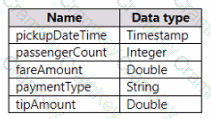| Exam Name: | Implementing Analytics Solutions Using Microsoft Fabric | ||
| Exam Code: | DP-600 Dumps | ||
| Vendor: | Microsoft | Certification: | Microsoft Certified: Fabric Analytics Engineer Associate |
| Questions: | 166 Q&A's | Shared By: | leena |
You have a Fabric tenant that contains a lakehouse named Lakehouse1. Lakehouse1 contains a table named Nyctaxi_raw. Nyctaxi_raw contains the following columns.

You create a Fabric notebook and attach it to lakehouse1.
You need to use PySpark code to transform the data. The solution must meet the following requirements:
• Add a column named pickupDate that will contain only the date portion of pickupDateTime.
• Filter the DataFrame to include only rows where fareAmount is a positive number that is less than 100.
How should you complete the code? To answer, select the appropriate options in the answer area. NOTE: Each correct selection is worth one point.

You have a Microsoft Power Bl report named Report1 that uses a Fabric semantic model.
Users discover that Report1 renders slowly.
You open Performance analyzer and identify that a visual named Orders By Date is the slowest to render. The duration breakdown for Orders By Date is shown in the following table.

What will provide the greatest reduction in the rendering duration of Report1?
You have a Fabric tenant that contains a lakehouse named lakehouse1. Lakehouse1 contains an unpartitioned table named Table1.
You plan to copy data to Table1 and partition the table based on a date column in the source data.
You create a Copy activity to copy the data to Table1.
You need to specify the partition column in the Destination settings of the Copy activity.
What should you do first?
You have a Fabric workspace named Workspace1 and an Azure SQL database.
You plan to create a dataflow that will read data from the database, and then transform the data by performing an inner join. You need to ignore spaces in the values when performing the inner join The solution must minimize development effort. What should you do?